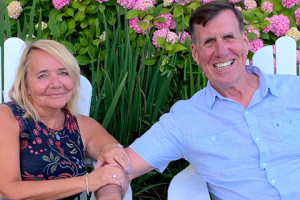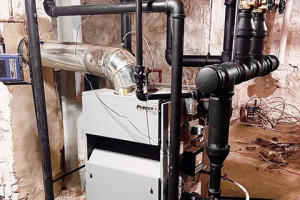
Hello, old friend. I’m writing today to say thanks, and to say farewell. This will be my last column.
There are some things you can’t help but notice about Denmark. They have windmills, but not of the Don Quixote sort. No, these are huge, three-bladed, high-tech monsters that whoop in a wind that never seems to stop blowing across this low-lying land. You can spot these graceful behemoths from miles away. The people of Denmark turn the wind into light.
At the airports, you’ll find the usual metal detectors and x-ray machines at each departure gate. The difference here, however, is that no one operates them. In fact, they place chairs in the middle of the metal detectors so that you are sure to walk around, rather than through, them. I asked about this and was told that no one has ever highjacked a plane in Denmark. In fact, they laughed at my concerns over such things. When asked why they had the machines there in the first place, they said that they had bought them, and then gave the whole issue some additional thought. Then they shut them off.
People are calmer here.
And they’re also honest. As you drive the roads of Denmark you’ll see numerous bicycles parked on their kickstands nears bus stops. That’s how most folks get to work in a country where the government requires a 180% tax on already very expensive new cars. And in case you’re wondering, gasoline costs about six dollars a gallon.
So they ride their bikes to the bus stop, and they leave them there all day by the side of the roads, on their kickstands – without locks and chains. And when the bus brings the people of Denmark back at night, their bikes are still there.
Imagine that.
The Danes, of course, are physically beautiful, and nearly everyone speaks English, and many of the homes have thatched roofs and it’s very, very green there. You’d like it a lot.
I stopped in Denmark in March, 1999. I was on my way to the big ISH fair in Frankfurt and Bill Boss of Danfoss invited me to take a couple of days before the show to see how his company made things. And that’s how I got to meet the Nozzle Man.
His name is Knud Mölholm. He’s a bit older than I am, and he has a handshake that made me wince. He looked at me with knowing eyes that were wrinkled at the corners as if he had been trying to stare three miles past the horizon from the helm of a sailing ship. "Welcome!" he said with a huge smile as he jerked my arm up and down. "Welcome to Danfoss!" And then he grabbed me by the sides of my shoulders and shook me. "You are the magazine man," he shouted. "I read you!" And then he shook me again. "Welcome! Now, we make a nozzle? Yes?" I nodded and smiled. He let me go, gave me a thumbs-up gesture as if we were leaving for the moon and shouted, "YES!"
And then for the next hour or so, I was held captive by Knud Mölholm, the Nozzle Man, and his white-hot passion for making a rather small item that you probably don’t give much thought to from day to day. I sure didn’t.
I do now, though.
There’s a hole in a oil-burner's nozzle. You probably know that. But have you ever given any thought to how that hole gets there in the first place? I hadn’t. The Nozzle Man was about to change all of that for me, though. He strode across the factory floor, beckoning me to follow him with a waving hand. We stopped in front of a microscope he had set up. He hunkered down over it and twisted the dial and adjusted the light over a piece of white paper that had upon it what looked like several threads of straight black hair from an infant’s head. "Ah," he said as he squinted into the eyepiece. "I have a picture for you! Come. Look!" And he stepped back so that I could get a peek, and what I saw astonished me. What had seemed to be a fine hair from a baby’s head turned out to be a tiny, and very perfect, drill bit. It was as detailed as anything you would find in a hardware store, but it was impossibly small. I stood up, a bit dazed by what I had just seen. The Nozzle Man smiled at me and said, "Yes?" I nodded and smiled back. "YES!" he shouted, giving me his thumbs-up sign once again. "Come!" he said and marched off toward his desk. He handed me a hockey puck-size piece of metal that turned out to be an enlarged version of the part of a nozzle that surrounds the tiny hole. He then explained to me that when you drill a hole in metal, you have to give a lot of thought to the molecules of metal that are being pushed ahead of the drill because those excess molecules can affect the dimension of the ridiculously tiny hole and that would, in turn, affect the flame.
Now, there’s something you probably don’t give much thought to as you go about your day, eh? I had never considered it. But Knud Mölholm had. He then rhapsodized for a while about how they deal with this microscopic challenge, and then he marched me across the room to the machine that drills these tiny holes and I stood there for a good long time and watched. Then I tried my best to understand the minds of the people who can conceive of, construct and operate such machines.
And all to turn out an item that costs just a few dollars.
But we weren’t done. We moved on to the machine that makes the part of the nozzle that sits behind the hole and I learned that this part is made of German steel. "The same that the big horses wear on their bridles when they parade," the Nozzle Man exclaimed, gesturing about his head. "You see these beautiful horses? Yes?" I nodded. "YES!" he shouted, sticking his thumb up and then turning my attention toward the steel as it entered this machine. "The best metal in the world! Watch," he implored. "This one I make for you!" And so I watched as the sharp blades of the big machine grabbed the end of the German steel rod and cut it on perfect angles, and grooved it, and polished it and then placed it gently in a tray. And he picked up the tiny piece and put it in my hand and it looked like something from a jewelry store. "Come!" he said, and I followed him to yet another microscope. He put out his hand and I handed him the tiny piece and he hunkered over his microscope and finally shouted, "I make you a good picture!" And when I looked in the microscope’s eyepiece what I saw were absolutely perfect lines. It was like looking at pure mathematics. I stood up and smiled at him. "YES!" the Nozzle Man shouted, and stuck up that thumb once again.
From there, we moved on to other machines, each more amazing than the last. I met a woman who sits and checks the spray pattern of the nozzles by collecting the precise amounts of oil that land in this high-tech version of a Skee-Ball machine. It was one of those aspects of oil heating that I had never really considered. How do you build a nozzle with a solid pattern? And then how do you make a semi-solid one? And how would you know for sure that you had gotten it right? Thank goodness there are people in this world that are able to solve these challenges. I can only write about them.
Every single nozzle that left that factory was tested. They look at the pattern through a special light while the nozzle spins in a holder. The Nozzle Man showed me a nozzle that had failed the test and I could immediately spot the defect. "This is why we spin them," he said with a smile that lit up the room. "And notice how the oil never swirls!" he observed, stopping the nozzle’s rotation, but leaving the special light on. "People think it swirls this way or that way," he said, twirling his finger first clockwise and then counter-clockwise. "But not once it’s out of the nozzle – no swirl!" he shouted. "Look!" And he was right. It didn’t swirl. "You see?" I nodded. "Good! You learn!"
The robots at this place are amazing to watch. They blow the excess test oil from the nozzles, leaving just enough to keep the nozzles pure until they arrive on the job. The robots then put each in a plastic container, label each one, place them in boxes, label the boxes, seal the boxes and send them on their way. Watch one of these robots for more than five minutes and you’ll want to give it a name.
And that’s what I was doing when Knud Mölholm shook my hand again. I was thinking of a name for the robot. He left me there so that he could go back to the more important work of running his factory.
There are some things you can’t help but notice about Denmark. The passion of their people is one of those things. I hope the Nozzle Man reads this.
Thank you, sir.

Hello, old friend. I’m writing today to say thanks, and to say farewell. This will be my last column.

My six-year-old grandboy, Brendan, was in the vestibule of the diner when the bubblegum machine caught his attention. It was one of those spiral models that appeared in t...

Subdural posed a question on The Wall at HeatingHelp.com in the Strictly Steam section, where some of the sharpest knives in the drawer post every day. The question was a...